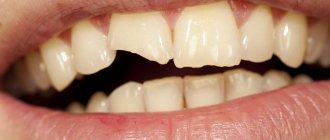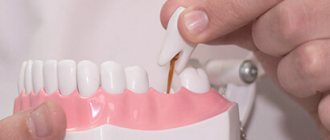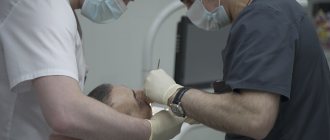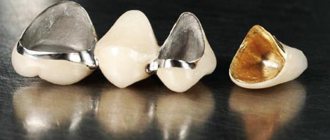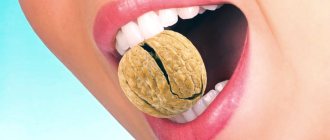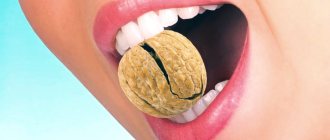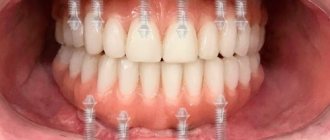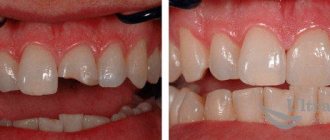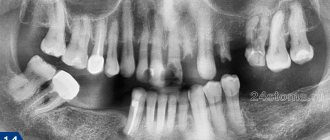Fracture of the front teeth occurs quite often in the practice of a dentist. This defect can be mild and affect only a small area of enamel, but sometimes the front tooth breaks at the root. What to do in such situations? Of course, go to the dentist. Today there are many methods that allow you to correct the problem, taking into account the individuality of each case.
The crown part of the front tooth is broken
If a front tooth is partially fractured, veneers or crowns can be used.
Veneers restore tooth function, protect dentin from external influences, and also the aesthetics of a smile. Treatment is only suitable for slightly damaged teeth. If the dental crown is severely damaged, the dentist will suggest installing a ceramic crown.
Crowns are placed on the remaining part of the tooth after grinding and preparing the surrounding area around the damaged tooth. If a significant part of the tooth has broken off, then to securely fix the crown it will be necessary to make a stump inlay, and in this case the tooth will have to be depulped (remove the nerve and fill the root canal).
The main stages of tooth restoration using a crown:
- Drawing up and agreeing on a treatment plan;
- Next, the doctor grinds the tooth down for a crown;
- Taking a silicone impression. The impression is sent to the dental laboratory. Based on the impression, the technicians reconstruct a plaster model of the teeth, and the technician will model the crown on it;
- When the crown is made, it is tried on and, if there is no discomfort, fixed on the stump.
To close the aesthetic defect, until the permanent crown is made, I install temporary plastic crowns on the patient, which can be made either in the laboratory or in the clinic.
Material for making dental crowns . Front teeth are a person’s calling card. When smiling, in conversation, every person involuntarily exposes his front teeth. Their beauty and health attract their interlocutor. This is why choosing the type of crown for teeth in the smile area is so important. The main types of permanent dental crowns are metal-ceramics, metal-free ceramics and ceramics with a zirconium dioxide frame. The most preferable material, from an aesthetic point of view, for the manufacture of dental crowns for the front teeth is metal-free ceramics e.max or feldspathic ceramics, also ceramics with a zirconium dioxide frame.
Why do chips appear on teeth?
Enamel is a durable transparent fabric. It reliably protects the tooth from destruction. However, there are a number of reasons why it may still break:
- eating too hard food
- mechanical injury (fall, blow)
- damage (cracks) in the enamel
- malocclusion
- untreated caries or incorrectly installed filling
- hypertonicity of the masticatory muscles
- partial absence of teeth, due to which the remaining ones are heavily overloaded
If a piece of a tooth breaks off, you need to seek help from a dentist, because over time, even a small chip can grow larger. The doctor will restore the beauty of your smile and comfortable eating, relieve psychological discomfort and increased sensitivity of teeth.
Restoration method – bridge prosthesis
Dental bridges got their name for their visual resemblance to a bridge - they are a structure of two crowns, between which artificial teeth are located.
Crowns are placed on your own ground teeth. The advantages of bridges are good aesthetics and reliable fixation. Dental bridges are permanent, making them very comfortable. This type of dental prosthetics requires several visits to the doctor. First, impressions are made, from which a temporary prosthesis is made in a denture laboratory or clinic - the patient will not experience discomfort when communicating due to the absence of a front tooth. At the same time, the dental clinic prepares the supporting teeth. They are ground to install a crown to a shape that is optimally suitable for this, and most often (but not always) they are depulped. After the grinding is completed, impressions are taken again, from which dentists make a permanent prosthesis, and after that it is installed on the supporting teeth and fixed with cement.
The main disadvantage of a bridge is the need for depulpation and grinding of healthy supporting teeth. In addition, its installation, which leads to an uneven load on the alveolar bone and its thinning in the area of the missing tooth..
What to do if a tooth is broken
It is clear that if a tooth is broken at the root, the patient will immediately consult a doctor, but one should not think that small chips and cracks can wait. The sharp edge scratches the tongue and cheek from the inside and can cause traumatic stomatitis. Cracks in the enamel deepen and lead to tooth hypersensitivity. A chip of any tooth affects the distribution of the chewing load. For intact teeth, it increases significantly, and this threatens additional injuries, now to these units.
Violation of the integrity of the tooth opens the way to internal tissues for pathogenic bacteria. Minor trauma can result in caries, pulpitis (inflammation of the pulp), periodontitis (inflammation of the tissue around the root), and ultimately, tooth loss. Therefore, a visit to the dentist is the first thing you need to do.
Restoration method - one-stage implantation immediately after root removal
Single-stage implantation of a front tooth involves immediately installing an implant into the socket after tooth extraction. For this type of implantation, special dental implants with aggressive threading and a high degree of primary stabilization are used. On the same day, immediately after implantation, a temporary plastic crown is installed. This implantation allows you to solve two problems - removing a broken tooth root and closing a cosmetic defect. In addition, the method allows you to save a little, because... Some manipulations are not performed (for example, the gum former is not installed).
After 3-4 months, when osseointegration of the implant is complete, permanent crowns are installed. Just as in the case of conventional crowns, from an aesthetic point of view, the best solution for the front teeth is the use of ceramic crowns and, accordingly, abutments. It is preferable to install the crown on a zirconium dioxide abutment, then in any type of lighting the crown will not stand out from the general row of teeth. In our opinion, this option for restoring a broken front tooth is the most optimal.
Damage to baby teeth
Has your child chipped a tooth? It’s not surprising, because children are very active, they often fall or hit themselves. As a result, the baby tooth may be damaged. Despite the fact that it is temporary, it also needs to be restored, because the health of the permanent teeth, as well as the correct formation of the bite, depends on the condition of the baby teeth.
What to do if a tooth chips? Disinfect your child's mouth and go to the pediatric dentist. He will apply a special gel and prescribe treatment. Typically, a baby tooth is restored with a filling.
Dental care in Moscow
In order to efficiently and inexpensively restore a broken or chipped tooth, contact our clinic.
We use:
- innovative treatment methods that allow you to achieve ideal results in the shortest possible time;
- durable, biocompatible materials, thanks to which the restored teeth do not differ from natural ones in structure, color, and light refractive index;
- advanced computer technologies that help create high-precision restorations and prostheses.
You can find out how much dental treatment will cost at a free consultation with a specialist. Sign up now!
Diagnosis of a fracture
In the dental office, the doctor, first of all, takes measures to relieve pain, then conducts a thorough visual examination to determine the severity of the damage. Its main task is to eliminate the likelihood of complications, such as:
- tissue necrosis, the symptoms of which are enamel staining and swelling;
- penetration of blood from damaged tissues into the internal cavity of the tooth;
- dislocation of adjacent teeth.
For a more accurate diagnosis, an x-ray is taken, which shows the direction of the fracture, the presence or absence of displacement, the condition of the root, and damage to the nerve endings.
- How long does it take for drugs to leave the body?
At the dentist
On a note! The final diagnosis is made only after analyzing the X-ray data.
To study the smallest details of the condition of the dental system, an orthopantogram (panoramic X-ray examination) or electroodontometry (allows you to determine the viability of the pulp in a deep fracture) can be prescribed.
Example of an orthopantomogram
Restoration of a dental unit with a removed root
Modern dentistry has two ways to replace a tooth in place of an extracted root - implantation and prosthetics.
Table. Modern methods of replacing a tooth at the site of the extracted root.
| Name, photo | Short description |
| Implantation | The process begins with the implantation of a titanium pin into the gum, which is gradually fixed and overgrown with gum tissue. After a certain time, an abutment is put on it - an imitation of a tooth, and then a crown of the required texture and shade, making the artificial tooth almost impossible to distinguish from the “native” one. Young patients can undergo rapid implantation (in one day). If treated with care, the service life of a restored tooth is 10 years. Implants from leading foreign manufacturers are provided with a lifetime warranty. |
| Bridges | The technology we mentioned at the beginning of the article has come a long way in recent years. Now, instead of radical turning, methods are used using plates attached to the back walls of supporting teeth (adhesive bridges), special micro-locks and other more gentle and effective methods. Removable bridges on crowns are fixed according to the telescopic principle (one crown is fixed to the tooth, the other is put on the first one along with the prosthesis). This method is considered the most reliable. |
- How to deal with unpleasant odors in the home of a seriously ill person
Separately, it is worth highlighting replantation - an exclusive method of restoration by returning the original tooth to the socket. Such operations are performed quite rarely, only when a newly knocked out tooth is brought to the dentist.
Replantation of teeth
First aid for a fracture
If an accident occurs before your eyes, you should make sure that the victim has no other injuries or a threat to life and only then focus on the tooth. Next, you should take it to the dentist as quickly as possible, having first tried to exclude infection and relieve pain:
- if there is bleeding, rinse your mouth with water, apply a piece of cotton wool or bandage to the injury site and press firmly - pressure will help stop the bleeding;
- for severe pain, give analgesics or NSAIDs, apply a cold compress (not ice);
- If you suspect a jaw injury, secure it with a bandage.
Cold compress
Chamomile infusion effectively soothes and disinfects open pulp; it is good if this remedy is at hand at the right time. Try to find the tooth or its fragments and bring it to the dentist, this will make it easier to assess the condition of the dental tissues and decide on the method of treatment.
Important! To avoid infection, perform all manipulations with clean hands.
Chamomile decoction
The most basic and obvious sign of such injuries is pain in a broken tooth, sometimes very severe, especially when trying to open or close the jaw. Fractures are also characterized by loosening of adjacent teeth, speech impairment, and bleeding gums. When the upper enamel layer is damaged, the pain is much less than when the deep tissues (pulp, dentin, root) are affected. Sometimes (this is extremely rare) a broken tooth may not hurt at all, but even in this case, seeing a doctor is necessary.
Broken tooth pain
Prevention of tooth fracture
Athletes and stunt performers can only be given one piece of advice - use a mouthguard, this will reduce the risk of injury.
Mouth guards are the key to health
General recommendations for maintaining strong and healthy teeth:
- take good care of your teeth, gums, and tongue;
- use high-quality certified toothpaste or gel with therapeutic and prophylactic additives to strengthen the dentition;
- take vitamin complexes for gums and teeth with dietary supplements and useful minerals;
- Eat a healthy, balanced diet. There should be a sufficient amount of fresh vegetables, fruits, cottage cheese, fish, and hard cheese on your table - this will help maintain the health of the soft and hard tissues of your teeth. Try to eat less flour, sweets, too hot and cold, salty, as well as foods containing preservatives, dyes and other “chemicals”;
Products good for teeth
- Maintain a balance of solid and liquid foods. Both excess and lack of chewing load are equally harmful to teeth;
- Seek medical help in a timely manner for infectious and chronic diseases, monitor the normal functioning of the gastrointestinal tract and metabolism. The consequences of malfunctions in the functions of internal organs cannot be eliminated with the help of expensive paste or repeated hygiene procedures;
- take vitamin complexes for gums and teeth with dietary supplements and useful minerals;
Vitamins for teeth and gums
- try to give up cigarettes, excessive drinking and other bad habits;
- If you have any problems with your teeth or gum tissue, consult your doctor. Fragility of dentin and inflammation of the roots are the causes of tooth decay;
- make it a rule to visit the dentist once every six months for a routine examination, even if nothing bothers you.
Visit the dentist every six months
Don't forget about the financial side of the issue. Dental augmentation is far from a cheap procedure, and the cost of implants is even higher. Preventing a problem is always easier than eliminating its consequences.
Is it possible to grow a tooth without a root?
If a tooth is without a root, there is no support for building structures. Therefore, it can only be restored with the help of implantation or prosthetics.
- Implantation. It involves restoring a lost tooth by installing an implant into the jaw, which acts as a tooth root. The top of the implant is covered with a crown.
- Dental bridge. It is a prosthetic structure consisting of several crowns welded together. The outer ones are attached to the pre-ground teeth adjacent to the defect, while the central ones remain hinged.
- Removable prosthesis Butterfly. Refers to temporary removable dentures. Indicated for hiding an aesthetic defect during the period of implantation or the manufacture of a permanent prosthesis. However, if the patient has contraindications to implantation and basic prosthetic methods, it can be used long-term. Attached to adjacent teeth using clasps.
Relationship between types of fracture and treatment
The specifics of treatment largely depend on the type of fracture you have. So:
- Vertical or longitudinal. The fracture line is directed parallel to the longitudinal axis of the tooth. In this case, it will not be possible to install the pin. It is also difficult to carry out pinpoint diagnostics. Therefore, in most cases, such a tooth must be removed. But keep in mind that the dentist must make the conclusion.
- Transverse fracture. In this case, the fracture line runs parallel to the chewing surface of the tooth. Treatment depends on how much of the tooth is preserved. If the molar was initially healthy, that is, this is not a fracture situation due to a carious cavity, then in 90% of cases with such a fracture, the tooth is restored. The damaged crown is usually augmented. The dentin and sometimes the pulp may also be removed. Recovery occurs at the base of the pin.
- Oblique fracture. In this case, the line goes diagonally. It is difficult to assess the likelihood of recovery in advance; you need to take pictures of the tooth and look at its general condition.
- Splintered. In this case there are several fracture lines. As a rule, the tooth is removed because it is quite damaged; the attempt to restore it will not give a good result. However, the final conclusion is made by the doctor.
If a person has several damaged teeth, the types of fractures can be different. In any case, you must first undergo a diagnosis.
THE RECEPTION IS HOSTED BY:
MNATSAKANYAN LAURA GRIGORIEVNAComprehensive professional cleaning of the oral cavity, treatment of caries and its complications, professional teeth whitening, aesthetic restoration of teeth, microprosthetics (veneers, onlays), dental prosthetics, implant prosthetics |
| What to do if you break a tooth? Is it possible to restore a broken molar or chipped front tooth? At the Cervantes clinic, where advanced technologies and modern materials are used to restore teeth, you can! | What to do if you break a tooth? Is it possible to restore a broken molar or chipped front tooth? At the Cervantes clinic, where advanced technologies and modern materials are used to restore teeth, you can! |
Direct and indirect method
Depending on the degree of destruction, when restoring the front teeth, as well as all the others, two methods are possible: direct and indirect. In direct cases, minor defects are eliminated using modern high-quality composite materials, which help bring the color and transparency of the crown as close as possible to natural values. The indirect method allows the use of onlays and veneers for restoration. For a professional dentist, extension is a simple procedure, regardless of its location in the jaw. Although, for example, restoration of a broken wisdom tooth is extremely rare due to difficult access. Most often, damaged wisdom teeth are simply removed, since they are a vestige and do not carry any functional load.
Price for extension per pin
Even when the crown part of the tooth is completely destroyed, it is possible not to remove the remaining root, but to build the tooth onto a metal pin installed in the root canal. For extension, composite materials are used, which are applied layer by layer to the pin, forming a new tooth.
The advantages of the method are the ability to preserve the root and restore the tooth if it is completely destroyed. The cost of the procedure at Doctor Bon dentistry is from 7,000 rubles.
| Tooth restoration with filling materials using anchor pins or fiberglass | 7,000 rub. |
Peculiarities
Doctors distinguish three stages of tooth decay: minor, partial and complete. Based on the amount of remaining living tissue, the dentist chooses the method and material for restoration. In some cases, it is enough to fill a small chip with a composite or partially build it up with appropriate materials to give it a natural color and shape. If the tooth is completely destroyed, the question of making a prosthesis arises. In this case, therapeutic treatment is pointless, and a prosthetist dentist is involved in the process.
Recovery methods
Qualified dentists, who have a wide range of modern technologies, strive to save the patient’s tooth in any situation. If the root has received minor damage or remains intact, there is always a chance of restoration of the dental unit.
Dental restoration methods
Restoration methods are divided into two large categories - with and without root removal. The choice of technology depends on:
- general condition of the damaged tooth;
- square hemp;
- the presence or absence of an inflammatory process at the root;
- volume of hard tissues;
- gum conditions;
- the presence of chronic diseases in the patient.
If caries, inflammation in the root canals, or dentin rot are detected, the remains of the stump are removed. The unsatisfactory condition of the external tissues inevitably leads to damage to the internal segment of the tooth located in the gum. Softened fragments of dental tissue, damaged by caries and injured, crumble easily. It makes no sense to leave such problematic roots and use them as the basis for recreating a tooth; they must be removed.
Often, the removal procedure is complicated by the incorrect position of the root (crooked, horizontal) or the small size of the stump with the impossibility of grasping it with surgical forceps.
Prepared tooth stump for restoration
The process of removing the root of a broken tooth includes:
- opening of the gums;
- removal of remaining hard tissue. The treatment is carried out using a gentle method using ultrasound (trauma is reduced, the recovery period after the procedure is shortened);
- dividing the root into parts in complex clinical cases. Such an operation may be accompanied by complications (in particular, alveolitis - post-traumatic infection and inflammation of the tooth socket), and long-term rehabilitation.
Tooth root fragments. The fracture line is deep under the gum
